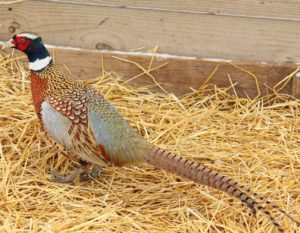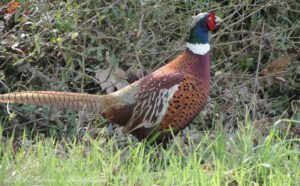Predators and Game Bird Populations
By Daryl Fisher. Biologist
One thought that often comes up when folks talk about not having enough pheasants or quail around, is the idea of predator control to increase bird numbers. It is true that predators destroy many eggs and kill young and adult birds. After all, that is how predators live, by killing and eating other animals. So, does it make sense to expend a lot of time, effort, and money in removing predators to increase quail and pheasant numbers? ( continue reading here ).
PHEASANT ECOLOGY: PREDATORS
No single predator gets more blame for pheasant predation than coyotes, but research over several decades has proven that coyotes focus their foraging on rodents and rabbits and do not take adult pheasants or nests as frequently as the other mammalian predators (red fox, striped skunk and raccoon). In addition, the larger home range and territorial nature of coyotes can actually result in lower populations of these other, more destructive predators. Predation accounts for three-fourths of unsuccessful nests, and nearly all of adult mortality (excluding hunting) is directly predator related. ( continue reading here )
There are a few important types of habitats that pheasants need in order to have an abundant population in an area. Nesting cover, brood-rearing habitat, and winter cover are probably the most important.
Pheasants are a very short-lived species. If you want to have an abundant population come hunting season, you need a lot of young birds, and that starts with nesting. If you have green wheat on your farm, you may already have a very good nesting cover. Pheasants nesting in a vigorous, healthy stand of wheat usually have good nesting success. Years with poor wheat stands usually result in poor pheasant chick production. Having some areas in a warm-season grass cover, such as Conservation Reserve Program (CRP) fields, or better yet, Continuous CRP (CCRP) borders, grassed terraces, or “wet” areas, can provide needed secure nesting cover during those years of poor wheat stands. (continue reading here )
Sources:
When to Hunt Game Birds and Game in Kansas
Kansas offers residents and out of state hunters some of the best game birds hunting in the US. If you have never hunted in Kansas before of you yearly partake in the sport of game bird hunting the information provided here will assist you in when to plan your trip and where to go for eventful prairie game bird hunting.
The season for hunting Pheasant and Quail in 2020 runs from November 14, to January 31, 2021. The daily bag limit in open area hunting for pheasant is four rooster males that drops down to two for youths. Keep in mind it is illegal to hunt hen pheasant in open areas of Kansas.
For exact season dates and Kansas Game bird Hunting and other game hunting Rules & Regulations Refer to the KDWP web site
Ring Neck Pheasants

Chinese Ringneck pheasant
The most popular of breeds, this pheasant is used primarily for stocking and hunting. The weight of the Chinese Ringneck at maturity is 2.7-3 lbs. for the cocks and 1.7-2.2 lbs. for the hens. These hardy birds adapt readily to the wild and are prized by sportsmen for their excellent flying ability and brilliant color.

Mongolian Ring Neck Pheasant
Mongolian Ring neck Pheasants
Are more common in the eastern united states It is a popular bird to hunt because of its size. There is plenty of meat on them for table consumption. Males reach an average weight of 3.5 to 4.0 lbs. They are hardy birds that because of their size they are more suited for European style hunts because their take off from the ground is a little slower than the ring neck pheasants.
Over time the two of these birds have been breeding together and have produced a hardy off spring that has a larger than a pure Chinese pheasant and has quick take off and are fast flyers. Here at Prairie Game Birds our pheasants are a mix of these two breeds. We are a closed breeding facility so our birds each year are raised from our breeding stock that is selected out of the premium birds from the previous year. Reports that come back from those that have purchased our bids and hunted them are they they are fast off the ground and in the air. We have no reports on how others say they taste when prepared but we eat them all the time and they are mighty tasty.
John